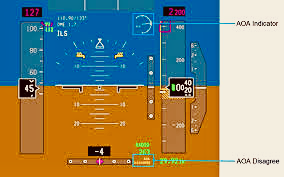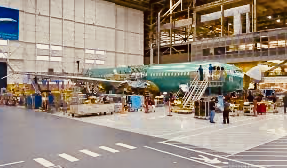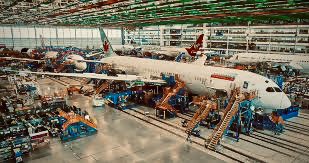737 MAX: The Fix Is In?📌
737-8: The MAX Factors (Premise).
+ 787 Dreamliners.☟
3/31/19—Months in the making, recent days in the doing: Looks like the Boeing 737 MAX 8/9 software fix is ready for rollout. Or at least that’s what the company would have us believe.
As black boxes signal faulty sensors/systems, Congress cites FAA lapses and a plane manufacturer’s ‘overconfidence that breeds complacency, complacency that breeds disaster’. And while airlines struggle with  revenue shortfalls and aircraft shifting/storage, the long-awaited ‘patch’ fully enters the testing stage.
revenue shortfalls and aircraft shifting/storage, the long-awaited ‘patch’ fully enters the testing stage.
A 737 MAX 8 remedy, which some Boeing engineers began designing last November after the LionAir JT610 catastrophe, began flight trials on February 7. It has also just been previewed by some 200 pilots, tech leaders and regulators. The ‘by invitation only’ Renton, Washington session featured a hands-on simulator demonstration—with which attendees were ‘very pleased’, despite reports that pilots had but 40 seconds to deactivate the MCAS anti-stall technology. Which does raise the question of whether airline pilots have become too dependent on cockpit automation in the first place.
Boeing describes the newly revised flight-control system as markedly more ‘robust’, incorporating ‘additional limits and safeguards, and reducing crew workload’—as in battling erroneous stall-prevention actions and the din of false alarms. Per earlier conjecture, the plane maker has activated a second angle-of-attack (AofA) sensor (which it had earlier gambled as too needlessly complex). This revision seeks to remedy a single-point-of-failure flaw in the initial MCAS iteration—particularly given Airbus’s triple sensor redundancy.
Otherwise, so much for simplified, ‘seamless’ training and operation on the fly, and for minimizing MCAS’s role in the MAX flight safety/control system. As a consequence, Boeing and the FAA had thrown unprepared pilots a fatally steep, sudden learning curveball, while underestimating the ‘lost in translation’ training pitfalls when it comes to overseas flight crews.
Along with that added sensor (both made by Rosemount Aerospace/United Technologies), the now standard fix includes a ‘disagree’ light that warns pilots when the  two AofA sensors’ readings diverge, to warn against inaccurate data (e.g., a 60-degree difference between the Ethiopian vanes; data reading problems on three previous Lion Air flights). Boeing will also retrofit this warning light on previously delivered airplanes, free of charge as well (options that had carried a $50k price tag). A key refinement is that MCAS will now be programmed to execute one anti-stall ‘dip’, rather than a repeated nose-drop sequence that likely caused the Lion Air and Ethiopian Air rollercoaster wrangle between MCAS and flight crews.
two AofA sensors’ readings diverge, to warn against inaccurate data (e.g., a 60-degree difference between the Ethiopian vanes; data reading problems on three previous Lion Air flights). Boeing will also retrofit this warning light on previously delivered airplanes, free of charge as well (options that had carried a $50k price tag). A key refinement is that MCAS will now be programmed to execute one anti-stall ‘dip’, rather than a repeated nose-drop sequence that likely caused the Lion Air and Ethiopian Air rollercoaster wrangle between MCAS and flight crews.
Idea being that pilots will be better able to pull back on their control column, so as to counteract the misfiring system. Further, two cut-off switches will be prominently designated on the cockpit pedestal to ‘disarm’ MCAS along with clearly updated flight manuals providing far more adequate info/data.
Pilot training on the ‘fixed’ flight-control system is said to consist of ½ hour of computer-based instruction, albeit without simulators, for all 737 pilots. Inflight testing is scheduled to begin shortly, with Boeing estimating that the MCAS’s per-plane upgrade can be installed in about an hour. The Chicago-based builder claims the entire MAX 8 fleet can be outfitted in a matter of weeks, if not mere days, with a full return to the skies in April.
So airlines are now invited to order the software/hardware fix, delivery pending approval and certification from the FAA. Carriers will then be able to install the patch, train their pilots according to their protocols, and give immediate feedback on the upgrade’s operational performance.
Cloudy Blue-Sky Thinking?
But will that scenario fly with an agency currently under such heightened scrutiny, Congress and the Department of Transportation shining their investigatory searchlights? The FAA’s credibility and reputation have been no less tarnished than the plane builder’s since Ethiopia ET320, mainly with regard to their perceived certification coziness, much less blaming the pilots on whom Boeing engineers had overly relied upon to blindly navigate the MCAS anti-stall squalls. And that they have shortcut the MAX rollout, and since been hiding behind their data screens, if not the 35-day partial government shutdown.
Even the Airline Pilots Association is questioning the efficacy of MAX/MCAS transparency and training. Thus while the House and Senate hold hearings and inquiries relative to MAX certification, the D.O.T. has seated a special committee for certifications of new aircraft, (namely 737 variants), its inspector general also tasked with ferreting out possible FAA regulatory shortcuts or shenanigans—not least why this fix process (“simply a few lines of coding”) has dragged on for months.
For instance, has discord between Boeing and the FAA stalled that software fix? Or does the fault lie not just with inadequate pilot training, but the manual’s entire MCAS corrective procedure? Clouding the ET302 picture even more is Ethiopian authorities’ initial post-crash claim that the pilots were not fully aware of MCAS manual overrides, only now to pronounce in a preliminary finding that the crew ‘went by the book’ on Boeing’s recommended cut-off of the MCAS’s automatic flight-control. But that the 737 flight manual-specified horizontal stabilizer/elevator moves did not enable Ethiopian Air’s pilot to yoke up, raise the MAX 8’s nose (via the plane’s trim wheels, its vintage cables and pulleys) in time.
Nevertheless, the FAA insists it has properly certified Boeing planes all along, been diligently ‘in the loop’ on this software fix, laser focused through the entire reparative process, and will conduct a ‘rigorous safety review’ before signing off. One of the agency’s concerns is that should a single (AofA) sensor go haywire in this new two-sensor redundancy, MCAS might not be able to determine which of the ‘vane’ readings is spot on. Therefore Boeing reassures that its anti-stall system will not now activate when the sensors are in notable disagreement, say by more than five degrees measurement.
Disagreement, indeed: Rumors are there is still some haggling over mandatory cockpit alerts and MCAS re-training, with the hard-pressed FAA pushing for even more rigorous testing, and extensive, self-guided pilot training on a laptop computer—an issue yet to be thoroughly resolved. Meanwhile, April projections for MAX 8 recertification are being challenged by analysts (‘try more like 3-6 months’), and by Canadian, European and other overseas regulators, who foresee a July reauthorization at best before the planes can safely fly again.
Off the Tailhook?
Bottom line: while firmly maintaining they’ve met all regulatory requirements and foresee a swift MAX 8 return, Boeing claims it still has the financial heft to weather even a months-long grounding with survivable impact (even an estimated $5b loss within two months). So as the giant company finally owns these two catastrophic failures, it must solve its overpowering flight-control problem amid Airbus subsidy tariff wars and the sudden lessor pressures of too many un-rentable aircraft. Meantime, Boeing continues building new  737s (albeit at a slower pace), paring a huge order backlog, selling even more jets worldwide, working to shore up its reputation, regain public trust beyond marketing and PR campaigns. Or as the White House offhanded suggests, they can simply ‘rebrand’ the MAX planes.
737s (albeit at a slower pace), paring a huge order backlog, selling even more jets worldwide, working to shore up its reputation, regain public trust beyond marketing and PR campaigns. Or as the White House offhanded suggests, they can simply ‘rebrand’ the MAX planes.
But its airline customers must struggle with the revenue and logistical fallout from the Lion Air and Ethiopian crashes—to where they are reduced to subbing older 737 variants, or 338 seat 787 Dreamliners for idled 189-passenger 737 MAXs. Concerning indeed, now that Charleston 787s themselves are under a cloud of loose ends and several recurring ☟production/quality control problems in Boeing’s ‘cost crunching’ South Carolina plant.
What with losing upwards of 5% of fleet capacity and precious revenue per available seat mile (RASM) on flights/routes they cannot currently serve, their compensation demands and discount deals are bound to tail Boeing in the turbulent months ahead. American Airlines is already extending its grounding, freezing new MAX orders well into August, Southwest doing the same—other carriers/customers following suit, dropping orders like landing gear.
As for the consequences to their customers, namely us travelers, what with rising passenger numbers and fewer available planes—more on that to come…
Meantime,Vamigré will keep scanning the skies to see whether the 737 MAX flight-control system is ultimately fixed or nixed. (MTC)…![]()
<< Into the AfterMAX.
☟
![]() As to the developing Dreamliner nightmare, the Department of Justice is probing 787 production at Boeing’s plant in right-to-work North Charleston, South Carolina.
As to the developing Dreamliner nightmare, the Department of Justice is probing 787 production at Boeing’s plant in right-to-work North Charleston, South Carolina.  Including subpoenas, the U.S. DOJ investigation encompasses everything from the carbon fiber, high tech Dreamliner’s SC roll out in 2012 to the latest 787-10 models.
Including subpoenas, the U.S. DOJ investigation encompasses everything from the carbon fiber, high tech Dreamliner’s SC roll out in 2012 to the latest 787-10 models.
Charges are that the program, which builds more than 50% of 787s overall, is plagued by manufacturing (fuselage, door, horizontal/vertical tail-flap fitting flaws) and supply problems, as well as chronically weak oversight, at least compared to, say, Boeing’s principal Everett, Washington plant.
Of little reassurance otherwise is the aerospace giant’s past record of safety lapses—including cabin oxygen issues, ‘foreign object debris’ left in finished wings to faulty wiring and fuel leaks to the lack of failsafe ‘lock wires’ on critical mainframe bolts. Then there were the cargo door blow-outs on Pan Am’s 747 back in 1987, followed by the fatal UAL Flt. 811 ‘explosive decompression’ over Honolulu in 1989, and not least, the TWA 800 fuel tank fire and crash in 1996, killing 230.
All along, Boeing has been sparring with the FAA over remedies, deadlines, compliance,  penalties and court settlements. As its profits soared, the company was accused of glossing over, stalling, cutting corners—outright lying. That is, until the 737 MAX flap landed with a tragic thump. Thus heads are already rolling (e.g., the 737 honcho’s).
penalties and court settlements. As its profits soared, the company was accused of glossing over, stalling, cutting corners—outright lying. That is, until the 737 MAX flap landed with a tragic thump. Thus heads are already rolling (e.g., the 737 honcho’s).
Still, CEO Elwell recently noted that prior to MAX/MCAS, Boeing airliners had logged 90 million flights, carried 7Bn passengers with but one fatality in the previous ten years.
Let’s see if he will be at the joystick as the next decade unfolds, proudly piloting Boeing up top once again. For to paraphrase, ‘if it ain’t Boein’, they ain’t growin’…
<<< Boeing 737: Hitting MAX 2.
<<< Accident Update: Lion In Wait.
